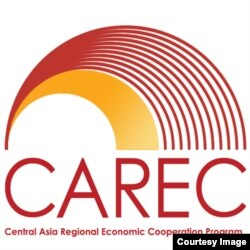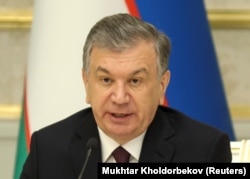Nine Central and Western Asian countries have signed an agreement in Tashkent that could pave the way for the creation of a regional energy market that could benefit billions of people from Europe to China.
But success for the project would require tremendous financial investment and a great deal of trust and cooperation between countries not always known for having close ties.
Officials from Afghanistan, Azerbaijan, Georgia, Kazakhstan, Kyrgyzstan, Mongolia, Pakistan, Tajikistan, and Uzbekistan met at the Central Asia Regional Economic Cooperation (CAREC) Energy Ministers’ Dialogue in late September to discuss how Central Asia’s energy export potential could be harnessed to bring electricity to markets in Afghanistan, Pakistan, China, and others, as well as opening up trade arteries to Europe.
A concluding declaration from the Tashkent meeting "sets the region on a faster reform path toward more liberal energy markets with greater private sector participation and investment, increased power connections and exchanges between countries, and a strong commitment to tap renewable energy sources and clean technologies."
The Asian Development Bank (ADB) launched the CAREC program in 2001 to "establish multimodal transportation networks, increase energy trade and security, facilitate free movement of people and freight, and [lay] the groundwork for economic corridor development."
Reconnecting Old Links
The project is designed specifically to improve the infrastructure in Inner Asia (broadly defined as regions in Central, East, and North Asia including parts of Mongolia, western China, and eastern Russia), giving the region new connectivity to countries in Far Eastern Asia, Europe, and the Middle East, but also bringing the Inner Asian countries closer together energywise.
The Energy Ministers’ Dialogue is an example of how the countries of Inner Asia could help one another by providing energy supplies rather than importing those raw materials.
At the core of this planned regional energy market is Central Asia -- an area rich in oil, natural gas, uranium, and possessing great potential for hydropower.
But it is also very important for the five Central Asian states to reconnect to each other, as they once did.
The five shared a unified energy grid in the last decades of the Soviet Union when a series of 83 mainly coal-fired power plants sent electricity across Central Asia, with Tashkent as the distribution hub. That system was especially important for mountainous Kyrgyzstan and Tajikistan, the keepers of water reservoirs that are vital to irrigation in Central Asia. Both countries have great but barely tapped hydropower potential, so receiving electricity from the three other Central Asian states was essential to homes and businesses in Kyrgyzstan and Tajikistan.
The breakup of the Soviet Union in late 1991 resulted in independence for the five Central Asian countries. But the energy grid remained -- and so did the dependence on one another for energy supplies, though not for long.
Turkmenistan withdrew from the Unified Energy System of Central Asia -- as the grid had been renamed -- in 2003. When Tajikistan drew too much power from the system in the early winter of 2009, the grid crashed and left parts of Uzbekistan without power. Tajikistan’s unilateral move also led to overloads and emergency shutdowns in Kazakhstan. Uzbekistan’s government quickly announced it was ending its participation in the unified grid. As the central dispatcher, Uzbekistan’s withdrawal meant the end of the grid.
This left the Central Asian countries scrambling to try to become as self-sufficient as possible for their energy needs. In the cases of Kyrgyzstan and Tajikistan, it led to boosting domestic coal production, which increased in Kyrgyzstan from some 1.23 million tons in 2012 to some 2.35 million in 2018, and in Tajikistan from some 412,000 tons in 2012 to some 450,000 tons in the first four months of 2019.
On September 2, 2016, authorities in Uzbekistan announced that Islam Karimov, the country’s only president since gaining independence in 1991, had died. Karimov had always been a major impediment to regional cooperation. But his successor, Shavkat Mirziyoev, stated that one of his primary goals was improving relations with Uzbekistan’s immediate neighbors.
That led to talk of reconnecting the unified energy grid.
In April 2018, Tajikistan started exporting electricity to Uzbekistan for the first time in some nine years.
The ADB approved a $35 million grant in November 2018 to help Tajikistan reconnect its electricity network to the Central Asian grid in Uzbekistan.
A few months later, the ADB approved a technical assistance grant of $4.5 million, part of which went toward studies for reconnecting Turkmenistan to the Central Asian Power System (CAPS) and extending the system into Afghanistan.
The countries of Central Asia will for the foreseeable future remain dependent on the Soviet-era transmission lines that connected them in the past.
There are new transmission lines in Central Asia, but they are internal and meant solely to serve domestic consumers, such as the Datka-Kemin power line connecting south and north Kyrgyzstan that was completed in 2015. Others were built for exporting electricity, such as the new lines from Turkmenistan, Uzbekistan, and Tajikistan to Afghanistan and possibly, one day, to Pakistan.
International financial organizations have been helping the Central Asian states repair and modernize Soviet-era power stations and transmission lines, while the focus of new power stations and power lines is on export markets.
How soon power from Central Asia will be exported to regional markets depends on financing and the situation in Afghanistan.
An ABD statement from the Energy Ministers’ Dialogue noted, "The capacity expansion will require sizable investments, estimated to be about $400 billion in cumulative investments up to 2030."
That amount of money will not be easy to raise for projects in Inner Asia.
And although there are power transmission lines from Central Asia to Afghanistan, those lines have not reached Pakistan so far, due to the unrest in Afghanistan.
Power transmission lines leading south from Uzbekistan and Tajikistan have been damaged by the fighting in Afghanistan several times. So long as security problems continue in Afghanistan, several major energy projects linking Central Asia to the subcontinent will remain on hold.
Whither Turkmenistan?
And Turkmenistan’s participation in the wider regional energy market remains in doubt.
It was notable that Turkmenistan, though being part of CAREC, did not send a representative to the meeting in Tashkent (nor did CAREC member China).
Turkmenistan has been anxious to realize its own projects to export its gas to Afghanistan, Pakistan, and India, and its electricity to Afghanistan and possibly Pakistan.
But Ashgabat so far has not given any clear signs it is ready to cooperate with the restoration of the Central Asian unified energy grid, though there have been talks about sending electricity from Turkmenistan’s gas-fired power stations across Uzbekistan to Kyrgyzstan and Tajikistan.
The CAREC project is incredibly ambitious, perhaps too ambitious, and not all of the goals set in Tashkent are likely to be met by 2030.
But CAREC has already made a difference in Central Asia, as a look at the map that shows CAREC’s six corridors in Central Asia, all of which are now open, shows.
One thing is for sure, however.
The energy market in Central and Inner Asia will certainly look much different in a decade because of CAREC.
(Note: This site describes CAREC’s six corridors and also shows that much of what China points to when speaking about its Belt and Road Initiative looks to be part of the older CAREC network.)









